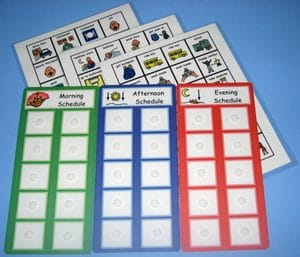Summer vacation is just about here for many of us, and we are all looking forward to some much-needed sunshine, warmth, and fun activities. Even with a relaxed schedule, and lots of fun on the agenda, our children with autism will continue to need extra visual supports to help guide them through the day.
Most of us like to have an idea of what is happening and how our day is going to look. Children with autism often miss much of the language and social cues that help the rest of us to understand what is happening. This “not knowing” can trigger anxiety and lead to resistance, simply because they are not able to anticipate the upcoming events of a given day.
Visual schedules are a powerful tool for people with autism. Not only can they provide information about what to expect, schedules also provide security and lessen anxiety – all of which are extremely important and will make the difference between a day of fun and a day of stress for everyone.

Visual schedules are a powerful tool that can help teach people with autism the importance of organization and structure.
Visuals can help a child who may process slowly, losing verbal commands and missing the message. The visual piece may be what your child needs for effective support. Keep the schedule simple to avoid confusion. A child often will have a much better recall having seen a visual schedule, versus hearing a verbal account of upcoming events. Using visuals can also teach the importance of organization and structure.
Children with autism often struggle with understanding facial expressions, gestures, body language, and vocal intonation. Social stories are another form of visual support that can be an effective tool to help a child understand what is going on by providing the missing cues.
You may have questions: How do I do this? How do I create a schedule? Where do I start? Can somebody guide me? There are many variations when it comes to creating a schedule – some have pictures, some have the written word, some have both. Some schedules are “hands-on,” such as having the child check off an item after completion; some are a simple, like a “first and then.” It is always important to figure out upfront what type of schedule will work for your child and your family. You should be sure you understand how it works and then teach your child to use the schedule. You also should be consistent in using the schedule for it to be a success. Keep in mind that it may take a little adjusting if it is something new in your home.
I will never forget the summer that I started using a visual schedule with my son, Logan. I found a laminated schedule board that had rows of clocks and a place to write in the time and activity. This was a huge hit with Logan, as he has a fascination with clocks. I was able to use these clocks as a guide to transition him from one activity to another. He loved it and followed it beautifully. I only wish I had discovered it earlier, because this made such a positive difference for Logan as his meltdowns diminished substantially that summer.
Here are some resources for using visual supports:
www.card.ufl.edu/resources/visual-supports
Another resource for you in developing a schedule is your child’s teacher. Check with the teacher to find out when and what type of schedule is being used successfully with your child in school. Other resources may be the psychologist who did your child’s evaluation or a therapist who works well with your child. You may also want to speak with the Autism Resource Specialists here at the Autism Society of North Carolina.
Come on, summer!
Juliette Heim, an Autism Resource Specialist in ASNC’s Asheville office, can be contacted at jheim@autismsociety-nc.org or 828-236-1547.
Tags: ASNC, Asperger Syndrome, Asperger's Syndrome, autism, autism asperger parenting tips, autism north carolina, autism society north carolina, autism society of NC, Autism Society of North Carolina, Autism spectrum, Developmental disability Go back
